You will have trouble remembering what I’ve written in this article — the first half at least.
Why?
Because it’s all words. There’s nothing to see. Nothing visually illustrating the concepts I share and the points I attempt to make.
Don’t get me wrong, I’ll try my best to help you understand what I’m saying; that’s the goal … but it’s an uphill battle.
I’ll use the visual tools at my disposal, like short, punchy sentences separated by whitespace and bold to highlight important phrases. Good copywriters are masterful at this.
I’ve written four books: Book Yourself Solid, Beyond Booked Solid, The Contrarian Effect, and The Think Big Manifesto.
That’s about 260,000 words in total. Each book is popular in its own right, but Book Yourself Solid has always been the most popular. In fact, it has a perfect five-star rating at Amazon.com based on hundreds of reviews.
Nonetheless, I meet thousands of people who don’t finish it. They tell me that they love it, that they need it, but that they don’t finish it. Why? They tell me that they don’t love to read — and I get that. It’s long. It comes it at 92,750 words.
This is a problem.
Don’t tell my publishers or agent, but I don’t care how many of my books are sold. Rather, I care about how many are used to produce more clients for the reader. If you don’t finish the book and implement what I’m teaching, how do you get the results you want? You don’t.
I’ve been concerned about this for a long time.
Enter Jocelyn Wallace, a master in visual strategy. When I saw how she could take ideas and make them easily understood, I knew what I had to do.
I had to create an illustrated edition of the book
Allow me to introduce: Book Yourself Solid Illustrated.
And it worked. Brilliantly.
I can say that because Jocelyn did 95% of the work. She forced me to cut about two thirds of the text and, as a result, we were able, through her illustrations, to convey more strategies, tactics, and tools to get booked solid than in either of the first two editions of the written book.
For example, in the original, it took me 20 pages to teach you how to create an information product. In Book Yourself Solid ILLUSTRATED, I do it with 5 images. Of course, I still offer some supporting text, but the combination of those two learning tools — text and visuals — helps you retain what you’ve learned so you actually use it.
Here are the first 4 out of 5 Steps to Developing Your Product. You’ll see what I mean.

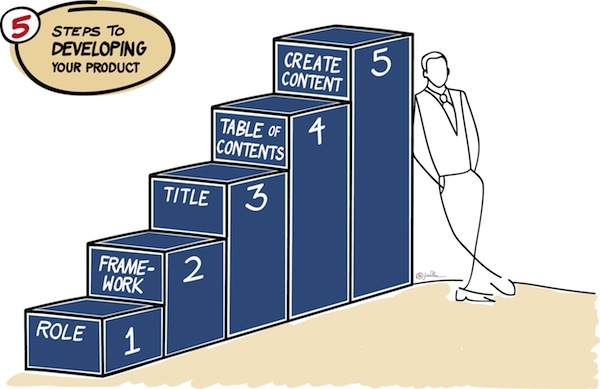

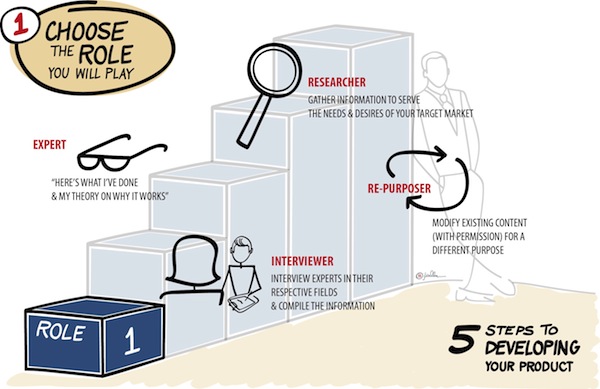

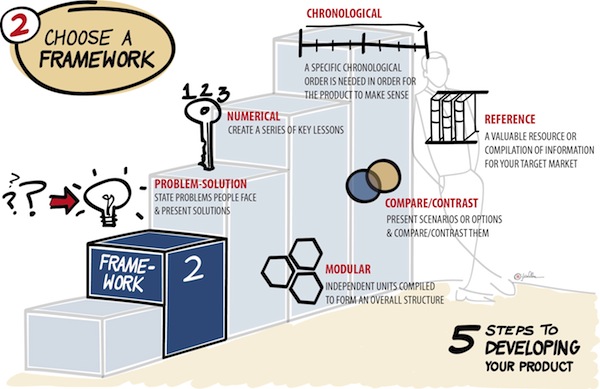

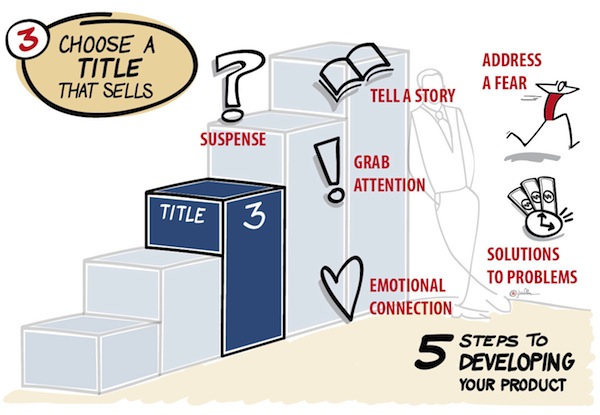


Or, take the Book Yourself Solid® system itself. Using words it takes numerous pages to describe the process. Now, I can show you this picture with just a bit of supporting text and you get it.

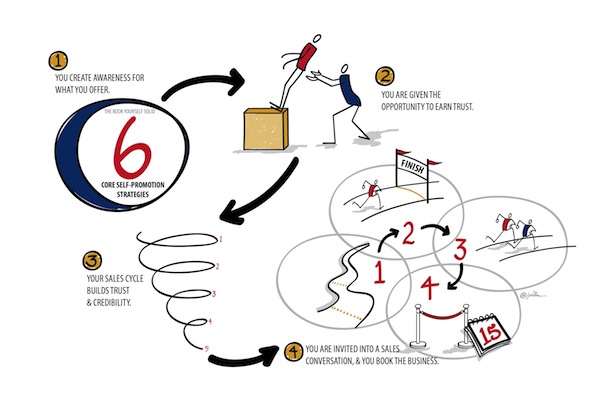
I said you wouldn’t remember the first half of this article. It’s likely that you can’t recall what I actually wrote outside of the fact that you will learn more if you see an idea than just read about it.
But you will remember these images. More importantly, if you don’t remember every step of the Book Yourself Solid® system, like how to create an info product, with these images you can simply pick up the book, glance at the illustrations, and get it. And it’ll take you all of 30 seconds.
Book Yourself Solid is a complete creative makeover to the original world-wide bestseller. Rather than slapping on a new cover or adding a “lost chapter,” I’ve delivered an ever-easier way to access the fastest and most reliable system for getting more clients than you can handle, even if you hate marketing and selling.
Thank you for taking the time to “read” this article. It’s an honor to be of service. I never take your time or attention for granted. I feel I have to continue to earn it and I hope I have with Book Yourself Solid.

Reader Comments (64)
Wow Michael!
That’s interesting. I’m a student of Visual Communications. I know how effective visual forms of data or content, can be. And, visual codings are so easy to understand and are attractive enough.
The first half, you really put up a lot of complex information in it. It’s the digits that confused me. I really wonder how did you count all those words even if you do it digitally (I’m very bad at mathematcs)
Hi Koundeenya,
Thanks for the comment.
I’m not sure I understand your question with respect to “counting all those words.”
Would you be so kind as to clarify? Thanks so much.
-Michael
You wrote 26,000 words for your books, I meant. That makes a lot.
26,000 words is a very few for a book. The original version of Book Yourself Solid has 90,000 words.
I’m not sure, but I think you’ve missed the question Michael. Koundeenya, to count the words in a document is not hard – usually as easy as “Tools > Word Count” in a word processor, and you get all the statistics in an instant.
Michael
you have explained for me why I never buy a book full of bland undifferentiated text. I go to chapters regularly looking at books they are going to help me in my business and I can’t help but reject ovum that have no lists no subheadings no illustrations. I have no interest at all in reading 30 page chapters in 500 page books.that might make me a bad person.
What I look for in a book is evidence that the author can break something down and make it readable kama enjoyable, and visually interesting. Your book seems do exactly that and I will have a good look at it next time I’m in chapters. Thanks for putting so much effort it’s a great material.
(apologies 4 the above comment having so many grammatical errors. I was dictating into my phone)
Hi Bill,
No worries about the typos.
My signature line in my email says: “P.S.” I don’t charge for typos; they’re my gift to you.”
I can’t see a typo if it’s flashing red and shouting, “FIX ME! FIX ME!”
I’m thrilled that you find the concept of the book interesting and engaging.
Have a look at the amazon page for the book as they have more than a hundred pages showing in the Look Inside feature. You’ll be able to see it right away rather than having to wait until you have time to go to Chapters.
Again, thanks for considering the book. No matter how many books I write and no matter how many copies are sold, I never take your attention for granted. It’s a privilege and I know it.
@Bill – Michael speaks the truth. I had the privilege of meeting him in person at a coaching conference in Miami in 2011. We had some amazing speakers at that conference – Stedman Graham, Dr Ivan Misner were two… but the most engaging and memorable speaker was Michael Port.
Michael, before meeting you I would write emails and sweat bullets hoping there wasn’t a spelling mistake… every now and then I’d miss one and get “called out” for it… and feel a little $%&#@!.
Since meeting you, Michael, and adding “I don’t charge extra for spelling mistake – they’re just my gift to you ;-)” to the end of ALL email, regardless who I send it to – I never worry… I quickly proof read and then [send]. Life is too bloody short. If someone gets worked up over a miss-spelled word… what ever!
Fantastic book Michael. I’ve enjoyed it. I look forward to receiving your illustrated version as well. Keep up the terrific work.
PS – great interview with Bob Burg as well.
It’s so funny that all of you talk about missing typos. I do the same thing. For years I would feel kinda insecure because I was supposed to be a writer, right? So why were there mistakes? My detail-oriented clients would spot every one of them and I would sheepishly admit that, “yes, that’s a mistake. I’ll fix it right away.” It didn’t matter how many times I read through the work, I would miss mistakes.
This was when I discovered editors.
Now I hire a copy editor to read through my work that has to be mistake-free. I’m happy! I’m liberated! I feel like a butterfly in the spring! She does what she does well and I do what I do well.
I love people who can spot those details but when they are my clients, I would get frustrated because they were so focused on the typo, I thought they were missing the point of the writing. But for detail spotters, typos loom so large they can’t see beyond them. Now that I hire a detail spotter as my ally, my detail oriented clients can relax and see the big picture.
Rant over. (wink)
Michael,
Thanks for this! You make some really great points. A good (copy)writer should use every tool available to make sure the reader keeps reading. Sometimes we forget those tools may not have anything to do with words. In my research for a recent ghostwriting project I came across the following statistic that underscores the importance of incorporating visual elements into our writing.
“90% of information transmitted to the brain is visual, and visuals are processed 60,000X faster in the brain than text.” (Sources: 3M Corporation and Zabisco )
BTW, for someone who has never read Book Yourself Solid, do you now recommend the illustrated version over the original?
Anthony
Michael, I know you did a lot of research to produce your first edition, and now this new edition of Book Yourself Solid Illustrated. I’m curious as to your understanding about visual learners vs those who prefer reading or listening. There must be an increasing number of visual learners now, is that correct? Personally, I like words better. Thanks for your enthusiastic sharing, as always.
Hi Mia,
My creative partner on the project, Jocelyn Wallace (http://www.jocelynwallace.com) is an expert on visual strategy and she helped me create something that I believe will have a big impact on visual learners. The good news is now we have text based learning styles (the original book), audio learning styles (audio book) and visual learning styles (the new Book Yourself Solid Illustrated) covered. I try to do my best to reach all those who can benefit from Book Yourself Solid and I hope that these three options will do the trick.
HI Michael,
Using pictures to paint images in mind – literally – takes much of the legwork out of the visualizing equation. We read words and then build pictures or images based on these words. Using images takes out the middleman, as you can picture images immediately. This is why your strategy is super smart. Love the idea.
I redesigned my blogs and squeeze page a few months ago, posting images of myself traveling all over the world. This is a different form of using images, consisting in selling a dream. I also post a video of myself chatting within each blog post and on my squeeze page. A bit different from your approach but the appeal is similar in that people see pictures, process images quickly and experience the quick benefit of seeing their dream manifest or receiving instruction through a more appealing medium.
Thanks Michael,
Ryan
Hey Ryan, I checked out your blog. Great stuff!
Michael,
I used your boring old un-illustrated book last year when I decided to leave my job and become a full-time freelance copywriter. it was rough for a while, but you’ll be proud to know that I’ve been booked solid since February 2013! So everyone out there who reads comments – the system works if you do the work.
I just pulled out the book and my workbook this weekend to work through it again because I want to narrow my niche and find higher paying clients. I loved the original, and I think the changes you’ve made are great. So do you think I should get your new version?
Hi Wilton!
Great to hear about your success. Look, I’m biased, so, yes, I want you to buy a copy of the new version of the book. I’ll say this: on one hand, if it ain’t broke, no need to fix it. On the other hand, the new version will help you access the content for review even faster. Rather than having to re-read chapters or modules, you’ll be able to look at the visuals to review what you need to do. In your case narrow your target market and find higher paying clients.
– Michael
Excellent point.
Thanks!
For the first time, I actually disagree with this post!
I couldn’t follow the last illustration. It was toooo simplified.
Though I am a visually oriented person, I love to read. I love to create the images of the descriptions in my head.
I am personalizing the illustrations.
Perhaps a balance of creative description and illustration would be a better way.
The visuals are so important and important for us to understand quickly, how ever to remember it for longer than a few hours, we need a deeper understanding. When you say “but it’s an uphill battle”, do you mean that it is not smart to exclude visual communication or do you mean that generations today are getting more hopeless?
I think the illustrations are fantastic!
I’m seeing more and more infographics on the web as a way to communicate information, but I wonder about blind or low vision people using screen readers like JAWS. How do they interact with this information? They would still need a text-version of the information.
This is brilliant Michael!
I personally love to read books, and I read your earlier version of the “Book Yourself Solid”… but this is a great point worth remembering, thanks for this! Love the idea.
You’re so very welcome Piotr!
– Michael
Great article. No doubt visuals are an important part of communicating a message.
Coming from a technical writing background, however, I have read studies suggesting (and anecdotal evidence confirming) that as the number of images rise, people read less and just look at the pictures. At some point (presumably) the level of imagery will get to the point where the reader will stop reading entirely and just look at the pictures.
My point here is to say that it’s not just about replacing text with images. We need to find the proper balance where they support but do not overwhelm each other.
We certainly may remember the images more, but if the images don’t tell the entire story, we’ve failed at communicating.
Great point, Scott. I agree with you completely Scott. Supporting text is essential. Each illustration is supported with descriptive text and each lesson is backed with with written exercises that, hopefully, engage the reader. Ideally, putting the reader in the story rather than just observing the story.
– Michael
I found the illustrations cheesy and did not want to look at them. Low-end illustrations tells me the book is not for me. I avoid this type of “how to” book at all costs–it screams cheap sales pitch and old info.
Hi JJ,
I’m sorry you feel that way. One thing I can promise you, however, is that there is nothing “low end” about this book. It was one of the most expensive to create books that my publisher has put out.
– Michael
Different people, different information processing strategies! It’s fantastic to have a visual book as well as a text based one. Get a hold of the Kolb Learning Styles inventory and you’ll see there are four strategies…it’s not ‘one size fits all” though most people are predominantly visual.
“You will have trouble remembering what I’ve written in this article — the first half at least.
Why?
Because it’s all words.”
Shh! Don’t tell the writers this….
I’ll grab a copy when it’s available in the UK, if it isn’t already 🙂
Right on Sarah.
I just finished Book Yourself Solid the other week and loved it. This is a cool idea; I’ll probably buy this version, too, as I’d love some more visuals to help me with retaining the content. Thanks, Michael!
You are a rockstar Jeff.
Just learning from the master.
Hey Michael,
Awesome post. A great change of pace from the typical Copyblogger content. I fully believe in the power of visuals. However, do you have more data to back up your claims about the effectiveness of visuals? Anthony mentions a statistic above, but I always like to see the numbers back up your points. Thanks.
Hi Ed. I appreciate that.
I’ve uploaded a PDF for you to review. This is an INTERNAL doc recently prepared by a member of my team to, based on academic studies, demonstrate the power of using visuals for educating.
https://s3.amazonaws.com/bys_illustrated/Pictures+and+Learning.pdf
– Michael
Hi Michael,
Thanks for this blogpost on word heavy vs. image heavy.
I love, love, love your book yourself solid book! Although I have signed up for more business development courses since reading it, and bought tons more business books as well, yours is the only one I have read cover to cover and continually returned to when I feel stuck or as if I need to take it to the next level.
The only problem I have had has been too booked, and gone into burnout mode…which I am now working on resolving. Personally, I remember words better then images, but I guess I fit into the minority.
Thanks again for the great communication skills!
Best,
Tysan
Wow! That is amazing Tysan. Thank you so much for sharing that.
You know I wrote another book for people who get too booked solid from the first book. It’s called BEYOND Booked Solid. You’ll find it at Amazon or anywhere books are sold.
Keep playing big Tysan.
– Michael
Hi Michael:
I read Book Yourself Solid about a year ago, right as I had quit my job working for a law firm and started my own practice. Also around the same time, I shifted my practice area to focus more on working with entrepreneurs and small business owners. In spite of the shift and the new business, I was busy from the get-go.
Ironically, I only got slow once I stopped focusing in a disciplined way on the lessons you teach in the book. For example, as I worked to broaden my reputation by blogging and podcasting more frequently, as well as networking with others who have similar online goals, I failed to continue networking with others on a local level, who have served as my primary source of referrals over the past few years. I need to either re-read BYS or pick up this new Illustrated version to remind me of the principles which were so helpful to me a year and a half ago.
Hi John,
That’s great news. I love hearing a success story like yours. I’m going to put my vote in for picking up a copy of the new ILLUSTRATED version. 😉
– Michael
I have actually been thinking about writing up a blog post on this topic for quite some time, breaking down the concepts in BYS and showing what I did and what worked for me. I have found writing those sorts of posts are really helpful for others and for me as well. (They remind me of the stuff I need to be working on regularly.) Once I get that written, I’ll be sure to share it with you.
Thank you for the article, Michael.
This is indeed a wonderful method for people that just can’t get through the book. But I realize another value for people like me who just love to read: Our problem is we have so much to read that we can’t keep up!
Even the late Carl Sagan estimated we can each only read about 4,000 books in lifetime, but I don’t think he had these books in mind…
This illustrated book concept is somewhat like a nicotine patch for us book addicts.
Michael,
Obviously something is broken in my brain, because words work very well for me. It helps to have illustrations as a complement to the words, but honestly, I have no idea what your illustrations said. I stared at them for a bit, and then asked myself why I am working so hard to understand this? My whole life I have quickly scanned charts and diagrams, and then looked for the information in the body of the text. I guess that’s how I ended up in the profession that gave us 14″ long paper.
— Ann
I’ll tell you Ann… I wish my brain worked like yours. I see big blocks of words and they look just like that – a big block. I know that’s odd coming from someone who has written 5 books but I find writing and reading very different experiences.
I can’t help but wonder how we get this to our NSANZ members. I love the visual steps although 6 needs to be truly thought about. I have noticed that smaller books get better reading. I work with (and am published on) the Corporate Toolbox One thing I notice is that the smaller, easier to read books are more popular. I think that is why I like creating workbooks and story books. And given the Kindle and epub formats for books, the more visual a book, the easier it is to get the message. I look forward to further connection
Hi Roberta,
Thanks for your thoughts. I’m with you all the way. What, may I ask, is NSANZ?
– Michael
Well I admit it, I do hate marketing and selling…and I think the visuals are refreshing, especially with a lot of content. So yes, I think I will pick up a copy. The testimonials sprinkled throughout the comments have me convinced!
Elise, maybe Book Yourself Solid ILLUSTRATED will help you fall in love with marketing and selling (secret: it’s a love story disguised a business book).
– Michael
Hi Michael,
Do you find any difference in how well pictures vs. words work in different ages?
My kids grew up with graphic novels, avatars, emoticons, and memes. They are very image oriented. They understand icons much faster and easier than I do. And when they scan a grocery aisle (or a Netflix movie list) they look at the images–not the words–to find what they want.
I grew up with reading lots of books. I find images difficult to understand if I need information from them. I scan words and skip over the images because I can’t process their meaning fast enough.
Your book illustrations are clear and easy to understand, but I found myself wanting a written, deeper explanation. I have read in many places that images are stronger than words, but I wonder if it is based on either age or the way information was processed as a child.
Thank you for an interesting post!
Hi Julia,
Great comments.
In the book, I offer written descriptions and examples to support the images. You could also look at it in the reverse — that the images support my writing. There wouldn’t be any way I could properly teach the Book Yourself Solid system through images alone. I believe it’s the combination of the two that make it powerful. I hope you do too.
– Michael
Hmmm… Good point. It doesn’t have to be either/or. I’ll have to get your book now and see what I think. Well done (wink)
Good points. The brain remembers pictures much better than words. It’s a good thing my book for middle schoolers has pictures the whole way through!
Great point on how images help entice the reader to continue reading and increase recall. Its crazy how much our society is image-based and what advertisers use to get us to buy their products.
Pictures worth more than a million words. We all tend to remember things we see than what we read
Great article which has really made me think about how I use my blog with text/ images!
Thanks for sharing,
Lauren
Your effort is great Michael!
You have built the schemes that are generally created by the most attentive (and probably wise) readers.
In order to be successful in this work the author should put himself in the shoes of the potential readers, possibly with the help of an external supporter. And this seems to be the way you followed.
I’ll put your book in my Wish List!
Hi Michael
fascinating article. The discipline of re-producing the article in a visual format is quite extraordinary although it seems the result was worth the effort. I guess our writing doesn’t have to be all or none. If we can incorporate more visual aspects than none, that’s a start.
Regards
Garry
Interesting post. Makes me want to get the book! I didn’t understand the last illustration though. 6 Core Promotional Strategies, but only 4 shown? Am I missing something?
Yes, Carrie. In the last illustration the 6 Core Self-Promotion strategies are just the first step in the Book Yourself Solid system. You use a few of them to create awareness, then you work to earn trust and build credibility with potential clients, if your offers are priced in the client’s sweet spot and you know how to have sales conversations at the right time, you book the business. The process repeats itself again and again.
This is a perfect example of why just a little supportive text along with illustrations is so effective.
– Michael
Hi Michael,
I was excited to read your post this morning!
Book Yourself Solid is by far my favorite client acquisition strategies book. It turned my notions of helping “just anybody” on its head and made me realize I had to develop my own ideal client profile. Your ideas are what counts – presenting them in a more visual way is a great way to help more entrepreneurs. Bravo and I look forward to seeing it and anything else you can develop!
Aimee, I’m so happy that Book Yourself Solid has been so effective for you.
And thank you for your kind and generous words of praise.
– Michael
Interesting article and I think you are spot on – kind of. The thing is people process information differently and that’s the #1 mistake I see in articles – too many people trying to fit all readers into neat little boxes. If I land on a blog and I see the post is a video, I’m gone. I prefer to read. In fact I read so much I can’t even remember the last time I turned on a TV. Other people, as you’ve illustrated, prefer visuals. Still others prefer audio. I don’t think the answer is a one-size-fits all solution, but rather to acknowledge and respect our differences and try to either offer information in a variety of formats or to at least find some kind of balance. Thanks!
Right on! You said what I wanted to say, and much better at that!
Hi Michael,
So, the debate I’m having right now isn’t whether to buy your book right now – it’s just “which edition” to buy 🙂 (nice problem for you right?)
If you’re not looking for feedback since you’ve gotten so much already, kindly disregard this message. But, otherwise, heregoes.
My problem is that while I’m a filmmaker and visual artist, I’m ultimately a storyteller and I learn best through stories. So, for me, reading a story is amazing (but time consuming). What attracts me to the illustrated version is all the diagrams and visual pictures to help explain a concept. What worries me, is that it might not have much beyond the illustrations.
From Amazon to your website, it all shows the diagrams and maybe a page here or there that has paragraphs to expand upon the diagrams, but how much “text” is there really? Are the diagrams 90% of the book or are they used to augment the text with each section just condensed (but still expanded upon) in words?
Having not read your first edition, I’m wondering if I’ll be able to understand and really get the “story” that the full text version might have. If the illustrated version has enough stories to connect to, I’d surely appreciate not having to read as many pages since I am rather slow and deliberate in my reading.
Travis
Provid Films
http://www.providfilms.com (under construction)
“I’ll tell on you”
Hi Travis,
It’s a treat to meet a filmmaker.
The Illustrated version is DEFINITELY the one for you. The illustrations support the text and the text supports the illustrations.
But, to be clear, 90% of the text has NOT been cut. The original version had over 90,000 words and this version has just over 40,000 words.
I need some text to tell the story that the visuals represent in order to support what you’re seeing. Personally, I think it’s the combination of the written storytelling and the visual storytelling that makes it so effective.
I hope you to a chance on the book. If you have ANY questions just post at http://www.facebook.com/michaelport and I’ll be sure to answer them.
Keep thinking big,
Michael Port
This article's comments are closed.